




In September 2023, the CCEC Board of Directors approved the retirement of $3.63 million in capital credits to members who purchased electricity from the co-op between 1997-2022.
Capital credits are a benefit unique to cooperatives. Think of them as your piece of the cooperative pie — you invest in CCEC by paying an electric bill, and we give a portion of that investment back to you when financial conditions allow.
Unlike other types of companies, CCEC and other cooperatives do not have shareholders who expect to make money from the company’s profits. We are not-for-profit businesses that exist solely to provide electric service to our members.
When you pay your bill each month, you are contributing to the equity, or your share of ownership, of the cooperative. The funds allocated to each member’s account are used to fund capital needs for items such as power line construction, transformers, trucks, inventory and other equipment.
2022: $3,514,332
2021: $3,440,690
2020: $5,193,436
2019: $4,636,539
2018: $3,240,463
When the co-op’s financial status allows, the board of directors will vote to return a portion of capital credits to the membership through a capital credit retirement.
Capital credits also help keep rates at an affordable level by reducing the amount of funds the co-op borrows to maintain and grow its electric distribution system.

We are holding more than $2.2 million in unclaimed money and want to get it back to its owners. When members move off our lines, they don’t always give us their new address. If a current address for a former member is not available, the funds remain in their closed account.
After three years, however, any unclaimed money is turned over to the state. That’s why it’s important for you to let us know your address and other contact information any time those change.
Visit ccemc.com/CapitalCredits to see a list of all members with unclaimed funds. If you see people you know, tell them to give us a call. We would much rather see that money go to our members and former members, where it belongs.

Your Touchstone Energy Partner®
The power of human connections.






Would



CHOKES OUT CRABGRASS
Men’s Garden club picked a Zoysia lawn as “top lawn—nearly perfect.” Yet, this lawn had been watered only once all summer!
NO NEED TO DIG UP OLD GRASS
5
“The hotter it gets, the better it grows!” Amazoy Zoysia thrives in blistering heat, yet it won’t winter-kill to 30° below zero. It goes off its green color after hard frosts, and begins regaining its green color as temperatures in the spring are consistently warm.
2 3
Plant Amazoy in an old lawn or bare ground. Set plugs into holes in the soil checkerboard style. Plugs spread to create a lush, thick lawn, driving out weeds. Easy instructions included with every order.
No weeding means no costly chemicals. Amazoy Zoysia lawns naturally resist insects, so you’ll save money, while helping to protect the environment. Never expose your family and pets to weed killers and pesticide poison.
1 4
FOR SLOPES, PLAY AREAS, BARE SPOTS AND PARTIAL SHADE
Can’t beat Amazoy as the low-cost answer for hard-to-cover spots, play-worn areas, partial shade and erosion on slopes.


6 7
AND WEEDS ALL SUMMER
Your established Zoysia lawn grows so thick, it simply stops crabgrass and most summer weeds from germinating!
NOW 3 WAYS TO START
YOUR AMAZOY ZOYSIA LAWN!
1) Freestyle Plugs come in uncut sheets containing a maximum of 150 – 1" plugs that can be planted up to 1 ft. apart. Freestyle plugs allow you to make each plug bigger and plant further apart — less cutting and planting — you decide.
2) Precut Super Plugs come precut into individual 3"x3" plugs ready-to-plant (minimum 1 per 4 sq. ft.). They arrive in easy to handle trays of 15 Super Plugs. Save time and get your new lawn faster!
3) Amazoy Approved Seed – As The Zoysia Specialists for 70 years, we now have a Zoysia seed that meets our standards and homeowners expectations.
ORDER TODAY – GET UP TO
Joseph P. Brannan Executive Vice President & CEO
Nelle Hotchkiss Senior Vice President & COO
Kristie Aldridge, CCC Vice President
North Carolina’s electric cooperatives provide reliable, safe and affordable electric service to 1 million homes and businesses. The 26 electric cooperatives are each member-owned, notfor-profit and overseen by a board of directors elected by the membership.
Why Do We Send You Carolina Country Magazine? Your cooperative sends you Carolina Country as a convenient, economical way to share with its members information about services, director elections, meetings and management decisions. The magazine also carries legal notices that otherwise would be published in other media at greater cost.
Your co-op’s board of directors authorizes a subscription to Carolina Country on behalf of the membership at a cost of less than $5 per year.
Subscriptions: Individual subscriptions, $12 per year. Schools, libraries, $6.
Carolina Country is available on digital cartridge as a courtesy of volunteer services at the NC Department of Cultural Resources, Library for the Blind and Physically Handicapped, Raleigh, NC 888-388-2460.
Periodicals postage paid at Raleigh, NC, and additional mailing offices. Editorial offices: 3400 Sumner Blvd., Raleigh, NC 27616-2950. Carolina Country® is a registered trademark of the North Carolina Association of Electric Cooperatives, Inc.
POSTMASTER: Send all UAA to CFS. (See DMM 707.4.12.5);
NON-POSTAL AND MILITARY FACILITIES: Send address corrections to Carolina Country, 3400 Sumner Blvd., Raleigh, NC 27616-2950.
All content © Carolina Country unless otherwise indicated.
Contact us
Phone: 919-875-3091
Mail: 3400 Sumner Blvd. Raleigh, NC 27616-2950
Web: carolinacountry.com
Email: editor@carolinacountry.com
Change of address: Please contact your electric co-op or go online to carolinacountry.com/address
Experiencing a power outage?
Please contact your electric co-op directly to ensure prompt service. Visit carolinacountry.com/co-ops to find yours online.

12
North Carolina native and country and bluegrass legend Jim Lauderdale onstage at MerleFest in 2023. Learn about how performers like Jim are keeping musical traditions alive — as well as where to experience bluegrass and Appalachian music live — on page 12. Photo courtesy of MerleFest/Heidi Holloway.
Where can you find the best hot dog in NC? What’s your favorite festival? Help us find the best in these and eight other categories! Submit nominations for a chance to win one of three $100 gift cards. See page 7 for details.
In this issue we’re looking at our typical April travel theme through a slightly different lens: music. After all, music and traveling go hand-in-hand, whether it’s a road trip tradition to pull out of the driveway with Willie Nelson’s “On the Road Again” blaring (that’s mine), or if the music is more of a destination. Learn about the latter on page 12, where we talk about Appalachian music, what it means for the state and where you can enjoy it live. And are you among those who made it to an Elvis show in the 1950s? Hear from others on page 16. Also, on page 6 read about how our state’s co-ops were recently represented by an inspiring high school student.
—Scott Gates, editorI just read the article “Insects Count” in the March issue (page 10), and I plan to participate in the Great Southeast Pollinator Census and encourage others to do so. I have shared with my Facebook group “Monarchs, Milkweed and More of Wake Forest,” other FB groups and with the NC Wildlife Federation because of their NC Butterfly Highway program.
The article is quite informative, but I noticed that the plant chart on page 11 listed Butterfly Milkweed, which is misleading. NC does have native Butterfly Weed (Asclepias tuberosa) [also sometimes called Butterfly Milkweed], but I have seen nonnative tropical milkweed labeled Butterfly Milkweed, which is not a recommended variety of milkweed because of negative issues with the health of Monarch butterflies.

On another note, Dr. Adam Dale of the University of Florida, an NC State graduate who grew up in Jamestown, has completed research showing that Monarchs are more readily attracted to milkweed planted around the perimeter of a pollinator garden rather than interspersed.
Thank you for this article, and for all your interesting and informative magazines each month.
Ann Rogerson, Wake Forest
A member of Wake Electric

The February “Where in Carolina Country is this?” photo is in Morehead City (see page 40). I used to go there with my grandparents because my grandpa was an avid fisherman. He loved fishing, whether it was out in the ocean or on the end of a pier. I always wanted to take him deep sea fishing one more time before he passed, but we never got the chance. He taught me how to fish, and then he taught me how to use an open-face reel. I always think about him when I’m on the pier fishing with my open-face reel. There’s nothing like fishing, whether you’re on the end of a pier, surf fishing or just straight up fishing from a lake. I miss those days with my Pops, just me and him and our fishing rods. Thanks for sharing the picture and bringing up a great memory for me. Nothing like the Blue Marlin to give you that good ol’ fight of reeling it in.
Candace Walker, Cherryville
A member of Rutherford EMC


We asked our social media followers a polarizing question: Are squirrels friend or foe? Do you ooo and ahhh over their cuteness, or curse their existence? Here are the results! (Along with a few reader comments.) Follow us on Facebook, Instagram and X to participate in future polls.
“We are in a wooded area, and love to watch them jump and play.”
Stephanie Jackie Thornburg“I love having them in my yard even if they do eat up all the birdseed I put out. They make up for it with their cuteness.”
Mandy Moore McLamb“A squirrel is nothing but a rat with good PR.”
Brian Hunter
“I
love them! Especially with rice and gravy!”Craig Ryan
51% Friend

49% Foe








From the French Quarter to the hometown of Mark Twain, experience the best of this legendary river. On an 8 to 23-day journey, explore Civil War history and travel to the epicenter of American music as you cruise in perfect comfort aboard our brand new American Riverboat™.
Small Ship Cruising Done Perfectly ®
























This month we take extra time to celebrate electric cooperative line technicians on Lineworker Appreciation Day.
Their job is among the top 10 most dangerous in the United States, according to the Bureau of Labor Statistics, but through a dedication to safety and training, North Carolina’s electric cooperatives are cultivating a highly trained workforce, capable of safely and thoughtfully responding to growth, system maintenance needs, and service interruptions.
It is critical that any response is done so with a high level of safety. Over the past decade, we have focused the function of safety on being proactive, and electric co-ops have made proactive risk management a part of their core values.
Through a dedication to safety and training, we are cultivating a highly trained workforce.
The first element of risk management is identifying our industry’s inherent risk and not “accepting” these known risks as just part of doing business. Yes, line work is traditionally dangerous work, but it doesn’t have to be. In the past, safety was solely based on meeting compliance — the minimum — and taking reactionary measures. Fast forward to today. We have adjusted our processes to include measurable goals, implementing action plans for continuous improvement. Part of managing anything is taking a deeper dive into understanding the influences, data comparison and, most of all, actual field application. By studying these areas and asking the hard questions, only then can organizations change and make real impacts on safety.
With this understanding, we can then focus on the bullseye of safety and not just hope to hit the target. Through a better understanding of risks comes a better focus on training, reliability and the continuity of service. For years, North
Carolina’s electric cooperatives have worked with community colleges across the state on line technician training programs and other workforce development initiatives — without these investments in training, a proactive approach to safety wouldn’t be possible.
Through safety training, electric co-ops have implemented processes and expectations that allow time to evaluate for hazards, and discuss mitigation and job process flow. Employees understand they have a shared responsibility not only on the jobsite, but in sharing and shaping their organizations’ safety culture, organizational goals and our future.
Another component of risk management we often don’t recognize is system reliability. New technology is creating a smarter grid, allowing for quicker responses and decreased outage times. System maintenance and upgrades have also positively impacted reliability, resulting in lower outage occurrences and outage duration, but the most significant impact has been increased safety for our line technicians — system reliability and decreased outage times directly decreases our line technicians’ exposure to risk.
Electric cooperatives have a big responsibility to our communities and the members we serve. Safety and training support this responsibility by preparing line technicians to respond safely in maintaining reliable service. It assures a brighter future for electric co-ops and their members, as well as a brighter future for our line technicians and their families.
Farris Leonard is director of Job Training & Safety Field Services for North Carolina’s Electric Cooperatives.
Along with strides in risk management, lineworker safety gear has improved over time. Watch the evolution (starting in 1875!) on carolinacountry.com/extras
Easy | Our easy-to-use Jitterbug® phones feature large screens, simple menus, powerful speakers and Urgent Response buttons. The Jitterbug® Flip2 has big buttons and one-touch speed dialing while the Jitterbug® Smart4 has voice typing, video chat and internet access.
Helpful | Whether you want to learn more about your new phone, need a ride or have a health concern, we’re here to help. And when you add Urgent Response, enjoy peace of mind knowing you can count on us, even in an emergency. Our kind and knowledgeable, specially trained, 100% U.S. based caring team listens and goes above and beyond in answering your questions.

In March, representatives from all 26 of North Carolina’s electric cooperatives joined thousands of peers from around the country in San Antonio for the 2024 PowerXchange conference, the national annual meeting of electric co-ops. Several discussions and sessions focused on ensuring grid reliability, including opening remarks by Jim Matheson, CEO of the National Rural Electric Cooperative Association (NRECA), the national trade association for electric co-ops.
“I want to hit the pause button. Preserve baseload power. Understand the opportunities and the limitations of wind, solar and storage. Appreciate the value of gas plants, nuclear power and hydroelectric dams. Build the transmission we’re going to need,” Matheson said, defining his main goal as continuing to engage federal regulators and elected officials, from Congress to the White House, to restore the point of view that reliability matters.
“It takes time to get this right,” he continued. “And in order to have a strong economy, growth and a better quality of life; we have to get it right.”
Haley Dorsey, Youth Leadership Council (YLC) representative and 2023 Youth Tourist sponsored by Blue Ridge Energy, took to the main stage to address the crowd of more than 9,000 on behalf of YLC. Each year, a Youth Tourist from each state is selected by their peers for YLC, an NRECA-led leadership workshop.
“I am not throwing away my shot. I’m just like my country, young, scrappy and hungry, so I am not throwing away my shot. Wise words taken from the Broadway musical, ‘Hamilton,’” Dorsey began her speech.
“I took my shot this year, from explaining to my cooperative members the simplified steps it takes to become a leader through my love for classical literature to explaining the important principles of a

cooperative and the tasks they are faced with as a great establishment with influence,” Dorsey said. “And now I’m here standing in front of you all today, to remind you of the ever-growing young leaders in this community. In my community.”
Representatives from North Carolina’s electric cooperatives shared insights in breakout sessions at the annual meeting, including Josh Winslow, CEO and general manager of Brunswick Electric; and Jason Caudle, COO of TEMA, a co-op organization that provides materials and supplies needed to operate and maintain the electric system.
At the TechAdvantage Conference, an event focused on co-op innovation and technology held in conjunction with PowerXchange, several representatives from North Carolina’s electric cooperatives presented during breakout sessions: TW Allen, manager of Engineering and Edge of Grid Assets for Tideland EMC; Jacob Barlow, senior project engineer for Randolph EMC; Don Bowman, COO/VP Engineering for Wake Electric; Tim Gubitz, manager, DER Engineering,

for North Carolina’s Electric Cooperatives; Angela Hare, VP of IT, Member Services and Metering for Central EMC; Jeff Loven, CEO of French Broad EMC; and Donald Webb, manager of Engineering and Operations for French Broad EMC.
Digital Extra
Watch YLC representative Haley Dorsey’s inspiring speech at carolinacountry.com/extras
 YLC representative Haley Dorsey
YLC representative Haley Dorsey
In February, the Carolina Hurricanes released a Black Excellence jersey in honor of Black History Month, featuring a design by North Carolina artist Mike Jones. Jones is the son of Michael Jones, safety coordinator for North Carolina’s Electric Cooperatives.
Jones drew inspiration for the design from “The Rose That Grew From Concrete,” a poem by the late rapper Tupac Shakur.
“A rose from concrete can be symbolism for not letting somebody deter you from blossoming or being successful, even if it’s in an environment where it doesn’t seem possible,” Jones said. “No matter the circumstances or adversity faced, you don’t let it become who you are and you can still become something beautiful.”
The Black Excellence jersey and shirts featuring the design sold out quickly. Proceeds from sales


will support the Durham Success Summit, a nonprofit providing professional development resources to young Black men.
Jones also partnered with Charlotte FC in 2023 to create a special edition


North Carolina Electric Membership Corporation (NCEMC) and the state’s electric cooperatives maintain a diverse power portfolio that includes natural gas-fired generation — a critical part of our fuel mix. But what makes natural gas so important?
NATURAL GAS IS RELIABLE.
Natural gas has the flexibility to be dispatched quickly any time, day or night, when power is needed.
NATURAL GAS SUPPORTS SUSTAINABILITY.
Natural gas’ flexibility makes it easy to ramp up and down to balance intermittent energy sources like solar and wind power, which supports future renewable energy growth.
NATURAL GAS IS AFFORDABLE.
Natural gas is an affordable and domestically sourced energy option that allows electric co-ops to deliver on a promise of providing electricity at the lowest possible cost.
This is the first in a series about what powers our lives — the diverse power portfolio that helps ensure a reliable grid. Future topics will include nuclear power and renewable energy.













 North
North







































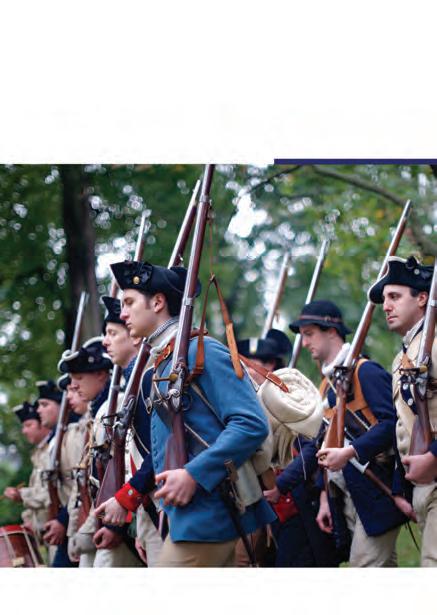

































For many involved in Appalachian, bluegrass and old-time music, the community is what makes it special, often nurtured through jams and sessions. These informal gatherings provide a place to learn new tunes or songs and connect with others in a welcoming atmosphere.
Folklorist Ron Pen describes traditional music as “the music that America comes home to.”
Our state is a regional hub for traditional music, largely due to the rich musical traditions of the Appalachian
Mountains and the Piedmont. The history of Appalachian music and its preservation is crucial to North Carolina’s cultural legacy, and there are many ways for people to get involved.
North Carolina is the tradition bearer of much of this music, rooted in Scotland, Ireland and Northern Ireland. Doug Orr and Fiona Ritchie’s book, “Wayfaring Strangers: The Musical Voyage from Scotland and Ulster to Appalachia” (UNC Press, 2014), tells the story of the journey of immigrants from Scotland through Ulster, then to America — down the Philadelphia Wagon Road to the Southern Appalachians. More than a quarter of a million immigrants came into America in the 1700s,
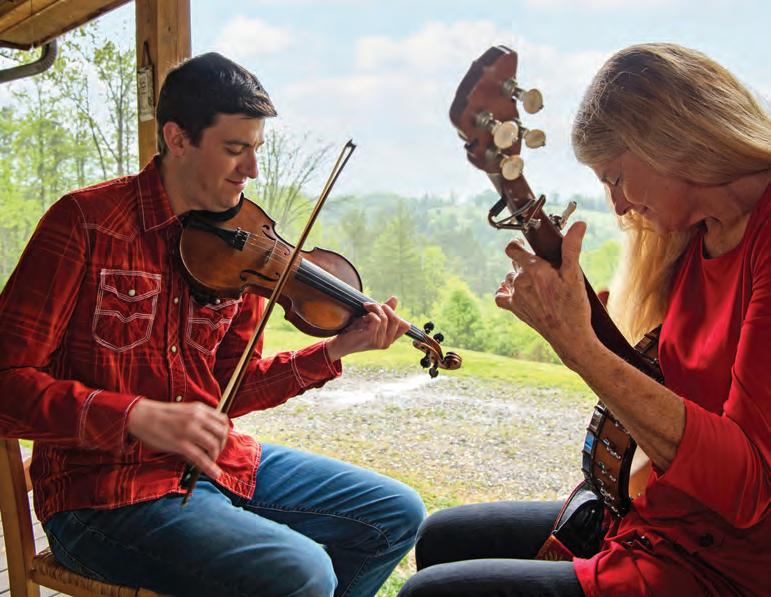
carrying their ballads, fiddle tunes and stories with them.
Ballads from the United Kingdom and Scots-Irish fiddle tunes mixing with African music and instruments (like the banjo), and Cherokee rhythms and melodies, eventually developed into the Celtic, old-time and bluegrass traditions we enjoy today.
Families that settled here continued passing down the musical and storytelling traditions to new generations.
“North Carolina has a major role in it, maybe more than any single state,” Doug says. Many immigrants settled in the Piedmont and western mountains of North Carolina.
The rich cultural heritage and legacy of traditional music illustrates the need to preserve one of our state’s proudest traditions. Doug has been at the forefront of these efforts by creating the Swannanoa Gathering (swangathering.com), a folk arts workshop series hosting five weeks of themed music instruction at Warren Wilson College since 1992.
Recognizing the mountainous setting and musical history of Western North Carolina as a perfect place for a traditional music camp, his dream grew rapidly. It now attracts over 1,500 people from across the world each summer to study with incredible musicians. Their Youth
Scholar program passes down the legacy by providing scholarships.
The most important feature of the Gathering illustrates the community of traditional music. “Students leave with the spirit of the community of the music,” Doug explains. “Each night, the moon’s coming up over the mountains, the fiddle tunes are in the air, the beer tent is flowing and friendships are being made.”
“Each night, the moon’s coming up over the mountains, the fiddle tunes are in the air, the beer tent is flowing and friendships are being made. ”
Laura Boosinger, a traditional musician (banjo player, guitarist and singer) and former executive director of the Madison County Arts Council, enjoys exposing audiences to the music and its importance.
“This is an important part of our American history, and I love being able to share the music with audiences who don’t have a point of entry into the music,” she says.
This love and reverence for Appalachian music has carried Laura through her extensive career, performing worldwide with acclaimed musicians David Holt (host of the PBS Show “David Holt’s State of

Music”), mountain swing fiddler Luke Smathers and virtuoso Josh Goforth, among others.
Studying Appalachian music at Warren Wilson College, she was welcomed into the rich musical traditions of the families of Haywood and Madison counties. Laura was intrigued by their stories and how “these mountain traditions stay so attached to families.”
Music has taken Laura around the world, but one of the things she’s passionate about is passing down the music through her work at the arts council and the Madison County Junior Appalachian Musicians (JAM) program.
“I think it’s my responsibility since people shared this music with me, I should also communicate it to folks and try to help kids get along in the music,” she adds.
JAM (jamkids.org), founded by the late Helen White in Sparta in 2008, is an after-school program providing inexpensive group instruction in traditional music. It’s grown substantially, with over 50 programs currently running across North Carolina and surrounding states. The Madison County JAM program thrives, serving 50 to 60 students each year, many staying involved through high school.
“It’s more than important to continue these cultural traditions
Josh Goforth and Sheila Kay Adams Lightnin' Wells Jim Gavenus
that make our area of Appalachia so unique,” explains JAM Executive Director and President Brett Morris. “To lose that would be a real tragedy.” Brett believes JAM helps children “be proud of where they’re from and get away from the negative stereotypes of Appalachia.”
In the Piedmont, the nonprofit PineCone, the Piedmont Council of Traditional Music (pinecone.org), offers youth bluegrass camps and jams to carry on the music.
“By teaching the next generation how to play, we’re giving them the tools to continue moving it forward,” says PineCone Membership Coordinator Lynda Dawson.
Music for all Blue Ridge Music Trails (blueridgemusicnc.com), an initiative of the North Carolina Arts Council and the Blue Ridge National Heritage Area Partnership, operates as a resource for traditional artists and visitors of the western 29 counties of North Carolina.
Their efforts to sustain and promote artistic traditions “foster an ecosystem where people can find authentic music and artists can rely on that as part of their income,” says Brandon Johnson, program manager at the Blue Ridge National Heritage Area Partnership.
One of these preservation efforts is the Mountain Dance & Folk Festival in
Asheville, started by musician Bascom Lamar Lunsford in 1928, continuing today as the longest-running folk festival in America. The Trails initiative created the Fine Tuned program, pairing young musicians with mentors for professional development.
Music and Dance Director at the NC Arts Council Jamie Katz Court describes North Carolina’s abundance of creative traditions perfectly. “I hope people recognize how rich and varied the arts community is here, and how lucky we are to have programs happening in every county in the state.”
Across North Carolina, many organizations, festivals and fiddler’s conventions nurture this community. The International Bluegrass Music Association’s (IBMA) World of Bluegrass Festival has been held each fall in downtown Raleigh for the past 10 years (it will hold its last festival in Raleigh in 2024) and bills itself as the largest urban bluegrass festival in the world.
“IBMA has really provided a vehicle for bluegrass to be seen by a larger audience,” says Lynda Dawson. It draws thousands to Raleigh, along with substantial revenue.
Another internationally recognized festival is Wilkesboro’s MerleFest, founded by iconic native guitarist Doc Watson in 1988. Both festivals engage youth through tailored performance
North Carolina is a hotspot for experiencing Appalachian, bluegrass and old-time music live and up close. Here are a few upcoming events.
MerleFest
April 25–28
Wilkes Community College, Wilkesboro merlefest.org
Shindig on the Green Select Saturdays in July and August Pack Square Park, Asheville folkheritage.org
Mountain Dance & Folk Festival
Aug. 1–3
Kittredge Theatre at Warren Wilson College, Swannanoa folkheritage.org
Carolina Bible Camp Bluegrass Festival
Sept. 14
Mocksville cbcbluegrass.com
World of Bluegrass Festival
Sept. 24–28
Downtown Raleigh worldofbluegrass.org

and educational opportunities.
The success of Doug’s book “Wayfaring Strangers” also provides hope for the future. It’s the fastestselling book in the history of UNC Press, and its success indicates strong interest in the music.
“Many of our great traditions in this country could easily be lost because we’re a transient culture,” Doug says. “The songs are deeply rooted in our history and persevere. It’s our responsibility to continue that tradition.”
Jessie Lang was a Carolina Country editorial intern in 2023 and has played traditional music since the age of 9. She is currently studying publishing, public relations & music at Belmont University in Nashville, graduating this May.




























































On a March night in 1956, country music star Eddy Arnold was scheduled to perform for the Lexington Civitan Club’s annual fundraiser. But as fate would have it, a last-minute cancellation sent a young, not-yet world-famous Elvis Presley to North Carolina as a replacement. Over 5,000 screaming fans were in attendance at the local YMCA gymnasium, police reportedly turned thousands away at the door, and Lexington has been all shook up ever since.
It seems that the people of Lexington can’t help falling in love with the King of Rock and Roll, even six

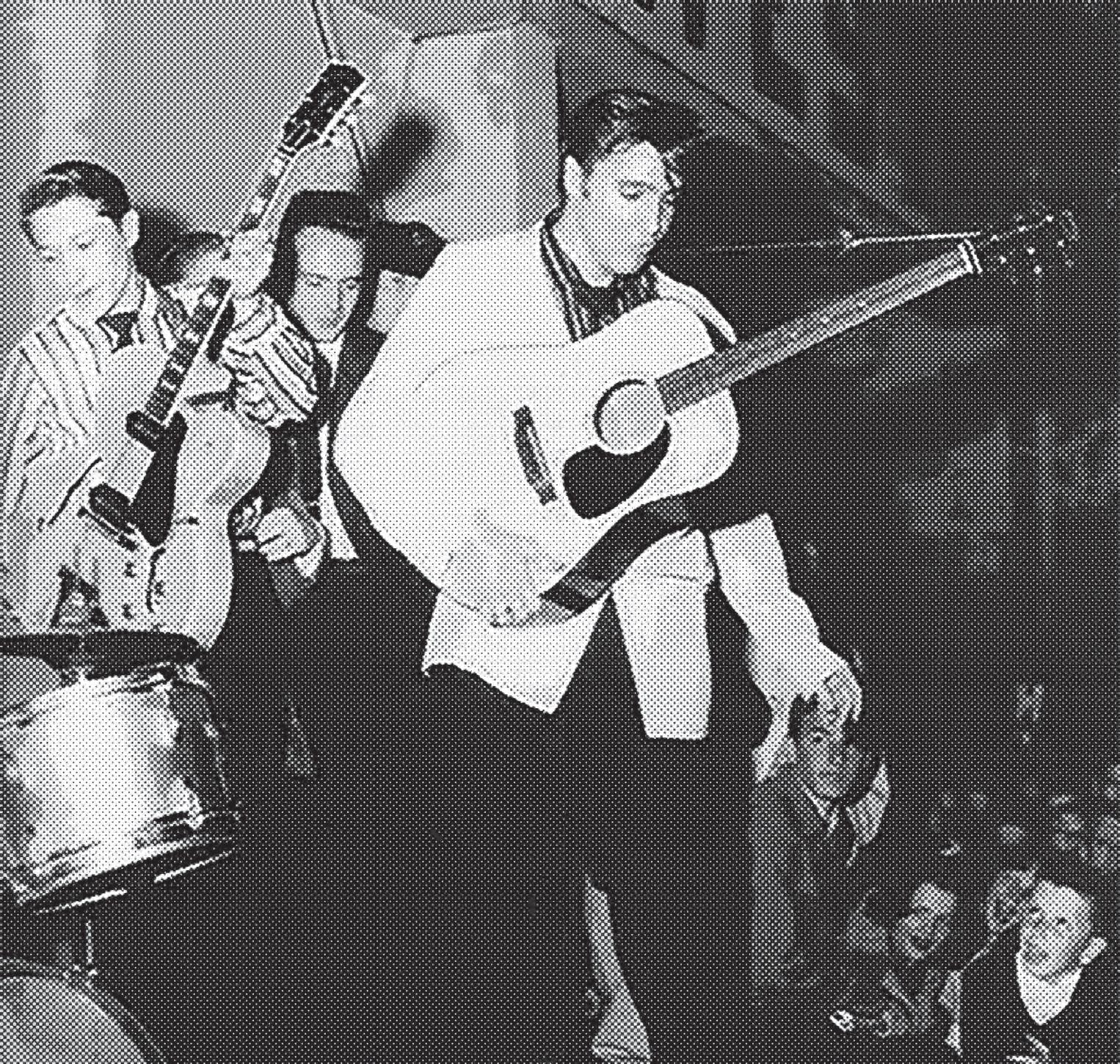
decades later. After the traveling Broadway-style “Elvis’ 56,” sold out, and a successful Elvis tribute concert was held in 2019, people began begging for more. With overwhelming interest, Lexington organized its first NC Tribute Festival to the King in 2022 and the town was all-in.
Lexington isn’t the only place Elvis stopped in the Tarheel State in his early performing days. In the spring of 1955, he was a relatively unknown performer when he toured with the Hank Snow All-Star Jamboree for multiple shows at the New Bern Shrine Auditorium, followed by appearances in Asheville, Raleigh and




Thomasville. In February 1956, he sent teenage girls swooning at the Carolina Theatre in Charlotte, where the press dubbed him a folk singer and a “good looking youngster.” Fresh off the recent release of “Heartbreak Hotel” and television appearances, his East Coast tour included stops in Greensboro, High Point, Wilson, Burlington and Winston-Salem.
“You can’t really define Elvis,” says Morgan Brinkle, executive director of the Lexington Tourism Authority. “He’s such a timeless, classic figure, and had such a huge impact on not only the music industry, but the world, from his rebellion to his music — everything.”
People are still fascinated with Elvis, and some people who attended that fateful 1956 concert are still in love with him, like lifelong Lexington resident Ramona Yarborough (who was 15 at the time).
“He was very new to us. He was unique,” Ramona says, now in her 80s. “We hadn’t heard all of that before, rock and roll.” Ramona attended the concert with her friend, Nancy Hunter, and remembers that it was packed, with people hollering and waving their hands, everyone thrilled that he was there. Later that year Elvis performed on The Ed Sullivan Show, and cameras would only rarely show anything but from the waist up. “Nowadays they show everything. Then, they wouldn’t even show him moving.”
“We ran up and down Main Street that night, trying to find him,” Ramona says. The concert promoters had said that he would be staying at the March Hotel, but he was actually at the Lexington Hotel. Ramona remembers being with a gang of friends, but being separated by the crowd. “Finally we invaded the place,” she says. “I guess that’s the only way you can say it.”
Her friend Nancy got to meet the King.
Long after Elvis “left the building,” sightings are still the subject or rumor and whispered about in small towns across the state. According to legend, he stopped in Lefler’s Cafe outside of Mount Gilead for a sandwich when the main road used to go by there. Amanda Keith, owner of Burnsville’s
NuWray Hotel, the oldest continually operating hotel in the state, heard rumors around town that Elvis stayed there before buying the property, though his name isn’t in the guest book. Still, the NuWray has one of its nicer rooms decked out with Elvis memorabilia, a suite fit for a king.
For the inaugural festival, merchants and small businesses on Lexington’s Main Street decorated their windows with Elvis decor and life-size Elvises. There were glitzy, pink and sparkly displays and some were more traditional. “Everyone had a lot of fun with the cutouts,” Morgan says. “You would drive by and it really looked like someone was standing in the window.”
But it isn’t just the business owners that have a burning love for Elvis. It’s estimated that approximately 1,400 people attended the first festival in 2022, many decked out in Elvis gear, each with their own spin on it.
“We see all kinds. Folks come dressed to the nines, like they are going to a Broadway show,” Morgan says. “We love seeing the little old ladies that come in with blue jean jackets, blinged with rhinestones and lots of glitter — everything head to toe Elvis, Elvis hat, Elvis purse, earrings, you name it. One of the kids wore a poodle skirt to one of the shows.”
Elvis hasn’t been spotted in Lexington since 1956, but the city and the rest of the Tarheel State still love him as much as a barbecue sandwich. Well, at least almost.
Ramona plans to attend the festival this year, being held April 26–28. “I think it’s going to be something that I need to review,” she says. “I think a lot of it will come back to me.”
Even for those with suspicious minds, the Elvis Festival is worth a visit.
“I think he’s always going to be around and always have a presence here,” Morgan says. “He’s such a timeless figure, and his music is timeless. Everybody loves it.”
Trudy

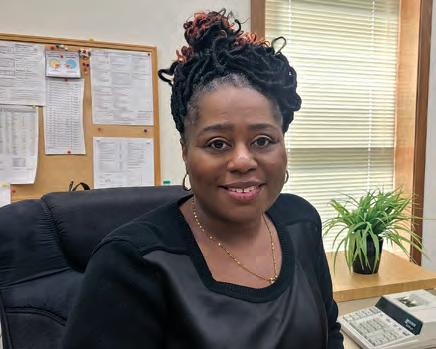
You might think of our line technicians when they’re hard at work during a storm that’s causing outages, but the reality is CCEC line crews work hard, day in and day out, to make sure members have reliable, safe electricity.
It’s no secret that a line technician’s job is tough. It’s a job that’s essential and often performed in challenging conditions. This month, as we celebrate Line Technician Appreciation Day on April 18, we want to recognize the outstanding individuals who served their community in this role — one that’s among the top 10 most dangerous jobs in the U.S.
Their work can be heavy, in more ways than one. Did you know the equipment and tools that a line technician carries while climbing a utility pole weigh up to 30 pounds? They’re also required to climb poles ranging anywhere from 30 to 90 feet tall. It’s not a job for the fainthearted! They often work non-traditional hours, outdoors in difficult conditions.
The job requires technical skills, years of training, and hands-on learning. Becoming a journeyman line technician can take up to five years of on-the-job training. That’s because working with high-voltage equipment requires specialized skills, experience, and ongoing mental toughness. Shortcuts are not an option and there is no room for error in this line of work. Despite the many challenges, CCEC’s line technicians are committed to powering our communities. They must be ready to leave the comfort of their
April


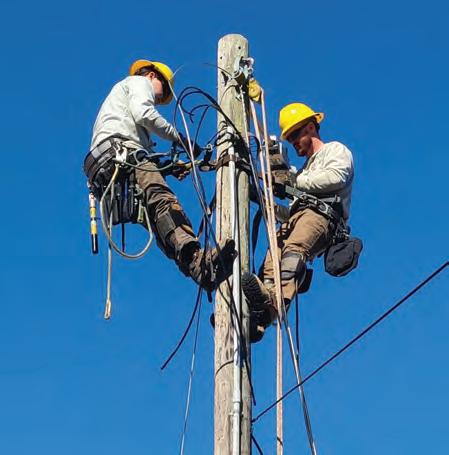
install a new service in Morehead City.
homes and families when severe weather strikes, without returning until the job is done, sometimes days later. That’s why the line technician’s family is also dedicated to service. They understand the importance of the job to the community.
CCEC line technicians maintain over 2,500 miles of power lines across our service area. Today’s line technicians are also information experts who use laptops, tablets, drones, and other technologies to map outages, survey damage, and troubleshoot problems.
Line technicians are essential to our quality of life. Without their exceptional dedication, we simply would not have the reliable electricity that we need every day.
So, the next time you see a line technician, please thank them for the work they do. Join us as we recognize them on April 18 by sharing your appreciation on our social media channels or whenever you see a line technician in your community.
With so many distractions today, it can be a challenge to engage students in the classroom. The co-op wants to help educators add unique and inspiring tools to their teaching toolboxes by providing funding for creative projects in PreK-12 classrooms.
CCEC is accepting applications for the 2024-2025 Bright Ideas Education Grant Program. Educators can apply for grants of up to $1,250 to fund projects that would not otherwise be funded through school budgets.
Teachers can apply individually or as a team, and grants are available for projects in all subject areas.
"Thanks to the generosity of our co-op, through the Bright Ideas Education Grant Program, my students have the opportunity to learn through a real-life, hands-on experience," said Morehead City Primary School teacher and 2023 Bright Ideas grant recipient Carla Starnes. "This grant provided me the ability to purchase an Aero Garden (an indoor hydroponics system) that expedites the plant growing process indoors."
"Lack of outdoor gardening space, unreliable weather factors, and time restraints of our academic units make this endeavor nearly impossible," Starnes continued. "With the Aero Garden, my students now have the opportunity to learn about plant life cycles through experiencing firsthand the process of planting, caring for, and harvesting their own crops."

Second-grader, Khari Collins, plants his seed in the Aero-Garden. It will take approximately five weeks for the plants to grow large enough to harvest for the class's "salad celebration."
Since the Bright Ideas Education Grant program began 30 years ago, the co-op has awarded nearly $616,000 in grants for 814 projects benefitting more than 168,800 students in Carteret County and Havelock schools.
The state’s 25 other cooperatives also provide Bright Ideas grant funding. North Carolina’s electric cooperatives have collectively awarded more than $15 million in grants funding 14,200 projects benefitting 3.5 million students across the state.
Apply now
Grant applications will be accepted through Sept. 15. Educators are encouraged to apply before Aug. 15 for a chance to win an additional $100 gift card.
To learn more and apply for a Bright Ideas grant, visit ncbrightideas.com.

Starnes explains how the Aero Garden works and students choose the seeds they would like to plant.
Whether you are new to college, looking for a new career, or planning to transfer to a four-year university, a community college scholarship from the Carteret-Craven Electric Foundation can help you meet your education goals.
The foundation will award scholarships valued at up to $1,000 each to four local community college students attending college in the fall of 2024.

Students can earn $250 a semester for a total of
four semesters of study. Scholarships will be awarded according to need and merit. To be eligible, the applicant must live at a residence that is served by the cooperative. Hurry! The application deadline is April 28. Visit ccemc.com/Scholarships for more information and to apply.
Since 1999, the foundation has awarded more than $64,000 in community college scholarships.

Glad Tidings Church, Morehead City
Doors open at 4:30 p.m. • Business meeting begins at 6:30 p.m.
Join us for:
A delicious meal
Energy information booths and displays
Musical entertainment by the Broad Creek Middle School Jazz Band and East Carteret High School Mariner Singers
Stay 'til the end for a chance to win:
Up to $1,000 in free electricity
One of several cash prizes
A retired co-op vehicle



The Nominating Committee met virtually on Feb. 15, 2024. Committee appointees are co-op members Zach Brewer, Robert Cox, Polly Johns, Cindy Meyers, David Peel, and Richard Scott.
The 2024 director nominees are:
DIRECTOR DISTRICT 1: Deloria "Dee" Irby (incumbent)
DIRECTOR DISTRICT 3: Jim Schmitt (incumbent)
DIRECTOR DISTRICT 4: Fred Fulcher (incumbent)
With Earth Day right around the corner, now is a good time to think about new ways to make energy-saving choices around your home. CCEC is here to help with your efforts. By implementing these green strategies, you just might save some green in the process.
One of the easiest ways to save energy all year long is by participating in the co-op's energy-saving programs.
Our time-of-use (TOU) rate gives you the potential to save money by using less energy when demand for electricity is high, or during on-peak hours. Alternately, this rate plan encourages you to shift your use of electricity when demand is low, or during off-peak hours, by paying less per kilowatt hour (kWh) than our standard energy usage charge. Visit ccemc.com/TOU for more information.
The co-op's Connect-to-Save (CTS) program gives members the opportunity to purchase smart thermostats for a discounted price. Members participating in CTS allow the co-op to minimally adjust their thermostat during times of high demand resulting in wholesale power cost savings that benefit the entire cooperative membership. Plus, smart thermostats save an average of 8% on heating and cooling costs. For more info, visit connecttosavenc.com.

Go green by opting into our paperless billing program. Paperless billing saves paper and you save on postage. To enroll, log in to your PowerPay24 account and click on "paperless" or call 252.247.3107.
When you make small changes to your energy habits, the impact can be big. We recommend the following energy-saving tips to help you save throughout the year:
è Consider installing a smart thermostat, such as what is available through Connect-to-Save.
è Insulate your electric water heater to reduce heat loss.
è Change your air filters monthly to improve air quality and keep your HVAC system in good condition.
è Unplug electronic devices and appliances when not in use.
è Close your blinds and curtains to keep the sun from heating up your rooms.
By putting these tips into practice, you can celebrate Earth Day all year long.
Unfortunately, in today's fast-paced, technology driven world, scammers are finding new ways to target utility customers. Scammers often call, threatening to shut off your power unless payment is made immediately, or call saying you overpaid and ask for credit card or bank information to provide a credit.
Many of these scam attempts sound something like this: the scammer poses as a representative of a company that you have an account with, says you are behind on the bill, and a truck is on the way to disconnect your service unless you pay your bill immediately — over the phone. Some scammers even ask their targets to purchase prepaid cards and call back with the prepaid card number to pay the bill.
Don't fall for these scams! CCEC will never call demanding immediate payment over the phone. Never respond to an email that claims to be from CCEC that
provides a link for payment or asks for personal information.
If you suspect someone is trying to scam you, call the cooperative at 252.247.3107 to verify your account status. Members who suspect that they have been victims of fraud should also contact local law enforcement.
For more information about how to protect personal information, visit the Federal Trade Commission's website, ftc.gov

NC 4-H Camps offer a 6 day, 5 night residential camping experience completely TECH free starting at $535/week!

Activities include horseback riding, canoeing, kayaking, team building and high ropes, swimming, arts & crafts, talent show and more.
We offer three unique and beautiful facilities in convenient locations across
All camps are owned and operated by NC State University and are American Camp Association accredited, adhering to the highest standards for safety and quality.


There are a number of reasons why people are interested in cutting back on energy consumption, and actively practicing energy efficiency and conservation provides multiple benefits. For parents, being more conscious about energy use teach kiddos about sustainable habits for the future. And I think we can all agree that saving money on our monthly utility bills is a great reason to monitor home energy use.
Regardless of why you’re interested in using less energy, there are several smart phone apps that can help you do just that!
Smart thermostat apps: Heating and cooling make up a large portion of the average home’s energy consumption (and cost!), so saving on heating and cooling can make a big impact on bills. Smart thermostats and their accompanying apps are handy and promote energy efficient behavior — and these devices have become much more affordable over the years. You can purchase an Energy Star®-certified smart thermostat for as low as $100, which can save you 8% on annual heating and cooling costs, about $50 per year. The device will quickly pay for itself, and you’ll gain insight into better ways to heat and cool your home. Plus, the ability to control the thermostat from anywhere can equate to real savings. We recommend trusted brands and devices, like Google Nest, ecobee and Honeywell Home smart thermostats.
Energy cost calculators: If you’re wanting to reduce energy use at home, it’s important to know where your consumption is going. Energy cost calculators can help pinpoint your energy use with a few simple steps and
identify areas to save. The concept is pretty simple: just plug in the wattage of your various appliances and how often you use them to see which are using the most energy. Most energy cost calculator apps are free and can be downloaded to any Apple or Android device. If you browse the app store, you’ll find multiple energy cost calculator apps, but most are similar in functionality. Be sure to read the app’s reviews and download the one that best aligns with your energy efficiency goals.
JouleBug app: If you’re competitive and enjoy gamifying — well, everything — the JouleBug app is right up your alley. JouleBug makes energy conservation simple and fun through personal tasks and badges earned within the app, group challenges you can tackle with friends, and communities you can join to learn about local sustainability efforts. The JouleBug app is free and can be downloaded to Apple or Android devices, and it’s an easy tool to make saving energy fun.
These are just a few apps that can help you find new ways to save energy. Smart light bulbs are typically paired with apps for convenient control of home lighting; smart plugs also come with apps to help you control how you power everyday devices and electronics.
Whether you use an app or not, saving energy is always a smart idea that can help you save money on your monthly bills while supporting a more reliable, sustainable grid.


















Think about your last vacation. What do you remember?
Did you hurry from one activity or place to another, getting a birds’-eye view of too many things to really enjoy the journey?
If so, there’s good news. Use 2024 to do something different: ride the rails to multiple destinations or board a riverboat on the country’s waterways.
“There’s a growing trend called ‘slow tourism,’ a chance to enjoy the journey, make memories, eat like a local, participate in experiences and discover the heart of a destination,” says Berkeley Young, president of Young Strategies Inc., a tourism research and consulting firm that works with destinations across the country. “You can travel by road, rail or boat; set your own pace; and create lasting memories — all without a passport.”
Ride the Rails
With more than 21,400 miles of routes and more than 500 destinations across 46 states and parts of Canada, travel via Amtrak connects people to big cities, small towns,
national parks, historic sites, popular travel destinations and off-the-beaten path adventures.
“Train travel can be a good alternative to driving or flying, and these days, customers have many options when taking a trip by rail,” says Kimberly Woods, senior public relations manager at Amtrak’s Washington, D.C., office. “Diverse destinations and the variety of routes and accommodations broaden choices whether you’re traveling with children, as a couple, solo or with a group of friends.”
Amtrak is the only national passenger rail service in the U.S., and in 2023, more than 28 million customers chose Amtrak nationwide, according to the company’s annual report.
“We’re seeing a strong increase in people who choose to travel with us because of the convenience, the chance to see more of the country than
flying, and the simple novelty of being on a train,” she says.
North Carolina has several dedicated lines for trips within the state, including the Piedmont line from Raleigh to Charlotte, and the Carolinian, which can take passengers from Charlotte to New York with several local stops along the way. NC stations also service lines running to Savannah and New Orleans. Visit ncbytrain.org for local deals and itineraries.
Amtrack leisure travelers can opt for overnight travel on several long-distance trains. The configurations of accommodations can include several types of service. First class offers private rooms with chairs that convert to upper and lower berths, larger bedrooms, family suites and accessible bedrooms. Coach cars have extra legroom and dedicated luggage storage.
The white-tablecloth dining car features traditional chef-curated menus. Customers can visit a café car to purchase more casual options for breakfast, lunch and dinner.
Passengers can also bring their own food, beverages and snacks. Basic Wi-Fi is offered, and passengers can travel with small pets or bring their bicycles.
In addition to direct routes, spur lines fill in across the lower half of the country. The Amtrak USA Rail Pass includes hop on/ off access for 10 segments over 30 days for a single fare.
“When you travel by train, you can be as busy or relaxed as you want,” Kimberly says. “You’ll have space to work, read, watch movies on your devices, have good old-fashioned faceto-face conversations or just sit back and look out the window to enjoy the scenery.”
The sight of a paddle-wheeler cruising down the Mississippi River conjures up romantic images of an earlier time in America’s history when waterways transported pioneers and settlers westward. Today, traveling by riverboat or small ship has been significantly modernized, yet the romance and adventure remain.
Companies that book riverboat cruises in the U.S. include American Cruise Lines (americancruiselines.com); American Queen Voyages (aqvoyages.com); RiverCruiseUSA (rivercruiseusa.com), which represents a wide range of river cruise lines; and Viking River Cruises (vikingrivercruises.com), an international cruise line that offers limited U.S. vacations.
“People today love the different twist on vacations in the United States that our small ships offer, and traveling the country’s waterways by riverboat opens a whole new experience that’s like a flash back in time,”
says Alexa Paolella, manager of public relations for American Cruise Lines. “No passport is required, and your hotel travels with you from port to port, so you unpack once. It’s a much more relaxed pace for discovery with more time to explore small river towns and picturesque shoreside villages, especially the places large cruise ships don’t go.”
American Cruise Lines’ fleet of 19 ships sail America’s coastlines and rivers. Accommodations vary from 90 to 180 passengers, depending on the vessel. Classic paddle-wheelers and modern riverboats navigate the Mississippi and Columbia rivers.
The company’s small cruise ships transport guests along both coasts of the country with itineraries in Alaska and Puget Sound to cruises exploring the New England coast all the way to the Florida Keys. It has also added national park tours to its offerings.
Many of the company’s itineraries are themed around music, history or cuisine that explore the distinctive characteristics of each ship’s ports of call.
“All our cruises offer a variety of experiences and activities ashore each day, providing access to larger cities but also the opportunity to relish the unique experiences only found in the smaller towns along the way,” Alexa says. “Onboard, curated entertainment and chef-prepared daily meals complement the comfortable and relaxing travel that comes with sailing on America’s waterways.”
Pamela A. Keene is a freelance journalist who writes for magazines and newspapers across the Southeast and nationally.

If you’re looking to stay closer to home or take a tried-and-true road trip, state and local visitors bureaus can help make the most of your journey.
“Some of the best planning resources are state tourism divisions and local convention and visitors bureaus,” Berkeley Young says. “Their job is to know their states, towns and counties and to provide easy ways to take a vacation that suits your interests and lifestyles.”
Visit NC (visitnc.com) is the one-stop spot for travel planning around North Carolina. Every state has a similar dedicated tourism department with staff whose job is to promote visitation by creating numerous trip plans for all interests such as music, culinary, cultural and historic. Research them first before drilling down to specific stops along the way via city/town or county-specific visitors bureaus and welcome centers.
“State and local agencies work with local attractions, accommodations, dining and special events and maintain extensive information about what to do, the best times to visit, outdoor activities and much more,” Berkeley says. “They have access to information about recommended routes and many times offer promotions for hotels, restaurants and attractions.”
Key travel planning resources include state tourism and economic departments and local convention and visitors bureaus.
Berkeley explains that true leisure travel is about the experience, but many vacationers are in a hurry to get where they’re going and miss the interesting discoveries along the way. “Just remember: Don’t sweat the tiny details. Determine the path you want to explore, book your transportation and some lodging, and get out there,” he says. “Fill in your itinerary as you go along. Meet locals and eat local. Be adventuresome; go find the real America.”

Stay in the home and neighborhood you love with a Stiltz Homelift.
The Modern Solution
A Stiltz Homelift is a safe, attractive, & affordable alternative to stairlifts. It requires no special machine room, and no supporting walls.
Economical & Flexible
A Stiltz Homelift can t just about anywhere in your house. It has a compact footprint, similar in size to a small armchair. A Stiltz Homelift plugs into a standard home electrical outlet, using less power than boiling a kettle.
Your Forever Home
Avoid the expense and distress of relocating, or the disruption of adapting your home for downstairs living. A Stiltz Homelift helps you live safely and independently in the home you love.
Some Stiltz customers need a Homelift immediately. But others want to “future-proof” their homes for when the stairs become a challenge.
Homelift Specialists
Stiltz is a world leading Homelift manufacturer, so you’ll be in good hands. Your elevator will be installed and maintained by Stiltz trained professionals - who truly care about your freedom.
“I can’t imagine what we’d do without it. I wish we had installed our Stiltz Homelift several years ago!”
– Mr. James, Roanoke VA






















Asolar eclipse wasn’t always an occasion for curious wonder. In ancient China, people panicked, fearing a dragon was eating the sun. General George Washington had to warn his troops of a coming partial eclipse on Jan. 9, 1777. If he hadn’t, he wrote, “this event, without previous knowledge of it, might affect the minds of the Soldiery, and be attended with some bad consequences.”
So it’s probably a good thing that we now have a firm grasp on the physics of when the moon passes between the Earth and our view of the sun.
The last total solar eclipse seen from our part of the world was fairly recent, on Aug. 21, 2017. That one crossed over the far southwestern part of the state, while most of North Carolina saw a partial eclipse. Only seven years later, on April 8, another celestial show is on its way.
For parts of the country, this day will mark an impressive total eclipse, with the moon covering the entirety of the sun. Here in NC, we’ll have a partial view, but a partial eclipse is well worth the effort, says Kenneth Brandt, director of the Robeson Planetarium and Science Center in Lumberton.
“Partial eclipses are still cool to see, as during most of the eclipse, you’ll be able to see the ‘crescent sun’ projected through small openings, like those in a colander.”
If you can’t travel to the path of totality, catch the partial eclipse at one of these locations, listed by percentage of totality.
Whether you view the eclipse at home or away, be sure to wear special eclipse glasses. Regular sunglasses won’t protect your eyes from permanent damage. Many local libraries will be handing out free glasses.
And if you miss this eclipse, or if it happens to be cloudy, future partial eclipses affecting parts of the state (though not as impressive as this year's show) will occur in August 2026, and January of both 2028 and 2029. Our kids and grandkids could enjoy the next total eclipse in North Carolina — on May 11, 2078!

88% Mount Jefferson State Natural Area, West Jefferson ncparks.gov | 336-246-9653
Visitors can view the eclipse with a park ranger from 1–3 p.m. at the Sunset Overlook. Eclipse glasses will be available.
86% Gorges State Park, Sapphire ncparks.gov | 828-966-9099
Ranger-guided half-mile hike to the Bearwallow Valley Observation Deck. Meet at the Visitor Center at 1:30 p.m., Only 30 pairs of viewing glasses available, so bring your own.
84% Lake Norman State Park, Statesville ncparks.gov | 704-528-6350
Event from 2–4 p.m. Limited supply of eclipse glasses will be available. Join park staff at the swim beach.
80% Dismal Swamp State Park, South Mills ncparks.gov | 252-771-6593
View with a park ranger from 1–2 p.m. There will be several activities, including a craft project. Pre-registration required. Limited glasses available.
80% Imperial Centre for the Arts and Sciences, Rocky Mount imperialcentre.org | 252-972-1266
Weather permitting, Tar River Astronomy Club members will set up telescopes for viewing. If you bring a shoe box or something similar, staff will help you make an eclipse viewer. From 1–5 p.m.
80% Morehead Planetarium and Science Center, Chapel Hill moreheadplanetarium.org | 919-962-1236
Outdoor sun-viewing stations. Science educators will be there to assist. Eclipse glasses available for $2.
79% Jockey’s Ridge State Park, Nags Head ncparks.org | 252-573-6108
Join park staff to view the eclipse. Complimentary glasses available on a first-come, first-serve basis. Begins at 1 p.m.
76% Fort Macon State Park, Atlantic Beach ncparks.gov | 252-726-3775
Digital Extras
Visit carolinacountry.com/extras for instructions on how to build your own solar eclipse viewer.
Park staff will have special viewing glasses and other safe-viewing equipment. Stop by the Visitor Center patio between 2:30 and 4 p.m.










A
$100
Two round-trip tickets to Cape Lookout National Seashore by Island Express Ferry Service.
One Beaufort Hotel Signature Mesh Bag for shelling. Two-hour kayak rental for two with Beaufort Paddle.
Tiki Boat Cruise for two by Cruisin’ Tikis Beaufort.

And that’s to be expected because yesterday, I put my personal watercraft in the lake, tuned up and ready for summer. Since the weather forecast promises a warm, clear morning, it’s time for the season’s first ride on the jet ski. That always means a sleepless night of anticipation for me.
From the first time I ever rode a jet ski, something resonated inside. I’m not the guy who jumps wakes and zig zags across choppy water, even though my chiropractor would love that. Instead, you will find me on the lake in the early morning when the day is new and the water is as smooth as a baby’s skin. That’s when I’ll be carving long, lazy turns, exploring sloughs, and looking at houses I can’t afford. All the while listening to the low, steady drone of the motor. It’s a peaceful, tranquil feeling.
At last, the sun peeked over the eastern horizon. I got up, ate a quick breakfast, and walked out on the deck. The world was still quiet. Lake Norman looked like a watercolor painting. It was time to go over a short checklist. A charged cell phone, my driver’s licence and boat registration — check. Finally, I grabbed a cheap pair of sunglasses. I highly recommend wearing them for a jet ski ride. Over a period of time, I have amassed a drawer full of them, so I’m totally unfazed if they blow off my face and into the water. I slipped on my life jacket, grabbed the keys and headed down the steps to the dock.
Once on the pier, I approached the Kawasaki and pulled off its cover. The ski’s red and black colors shone deeply, still gleaming from a recent wax job. I unhooked it from the port, inserted the key and started the engine. It cranked instantly, as if it couldn’t wait either.
Together we slid into the water.
For the next 3 to 4 minutes I headed up the channel just above idle speed. This is a trick my mechanic gave me to prolong motor life — warm it up properly! It’s difficult to do. The teenager in me wants to rock and roll immediately, but the adult makes sure I finish a slow dance first. I’m not sure, but I think it’s called maturity.
Finally, it was time. I turned the jet ski around and took a minute to take in the view. The water stretched out calmly for miles. The sky was a soft blue. Slowly, I got to a comfortable speed, allowing the ski to plane out smoothly. Then after about a quarter mile, I squeezed the accelerator hard.
It leapt out of the water. In an instant I was going 60 miles an hour. I screamed like a kid on a roller coaster. Houses zipped by as I began to make long wide turns. Within a few seconds I was on the main channel, which seemed to be completely deserted, except for a few fishermen. I slowed down to about 40 miles per hour, which is my perfect cruising speed, and began to look around.
Lake Norman is a beautiful place, especially when you thread your way up some of the creeks that feed the main channel. Eventually, the homes become few and far between, giving you an opportunity to truly admire God’s handiwork. Oak and hickory trees were festooned with new green

leaves. Occasionally a striped bass would break the water to get its morning meal. Once I was deeper in the backwater, I cut off my ski, and just listened for a couple of minutes. It was silent. Peaceful, perfect silence. I marveled at it all. It never gets old.
I headed back towards the main channel and began to sing. It’s not uncommon for me break into a song or two on a morning ski ride. Today it was the Allman Brothers, the Beatles and Steely Dan. It’s a good thing the roar of the engine drowns me out. This always reminds me of an old commercial for motorcycle insurance where the rider is singing, and the announcer says, “If you ride, you get it.” That’s a true statement — on a motorcycle and a jet ski.
Finally, it was time to get back to the house. So, I turned around, and with one more burst of speed headed home. After about a half mile, I looked to my left, and the wind blew my sunglasses off into the water. It’s no big deal — I didn’t even look back.
There was too much in front of me to see.
Joe Hobby is a comedian and a syndicated columnist who wrote for Jay Leno for many years. Find more of his stories on his blog (mylifeasahobby.blogspot.com) and follow him on Facebook
@Joe Hobby Comedian-Writer
In the 1950s, after Hurricane Hazel almost cleared Ocean Isle Beach [in October 1954], Odel Williamson offered ocean front lots for $1,500 if you promised to build within two years. My parents and two of their friends from Charlotte bought lots on the east end of the island as that is where the two-car ferry and pier were originally located.
Through the years, we filled the four-bedroom, two-bath home to the brim with family and friends. Some of my fondest memories were of the Betts Family Reunions where my father, his parents, siblings, cousins, dog Friskie and cat Honey Cat all gathered, as seen in the photo. The laughter still resounds in my head and I’m so thankful to my parents for building these enduring relationships.
We ate pounds of shrimp from Holden Brothers or Sheffields, had watermelon spitting contests off the back deck and enjoyed my grandmother’s mouth-watering sponge cake. Lunch was a loaf of bread and jars of peanut butter and jelly left on the table.
We had no TV, so puzzles, card games, even studying

The wooded area around our home was my playground growing up. There were two white pines in our front yard too fat to put your arms around. My siblings and I would hide behind them in a game of hide-and-seek. In the fall, we would stuff the needles up our sleeves and become scarecrows. The branches were just a ladder, waiting to be climbed. Sap stuck to my fingers, and I gathered bark as I made my way up the tree. Once at the top, the branches transformed into a comfortable seat. The view was extraordinary. I could see the tops of houses, fields of sugar cane and Table Rock.
At night, fireflies blinked their beacons, inviting new adventures. Once caught, we would use their tails to make fluorescent faces on the trees. One night, after

the encyclopedia questions for an end-of-the-week quiz and prize were our evening entertainment. A trip to Shallotte or Myrtle Beach was a true highlight.
My father taught me how to float over the waves and instilled in me a deep love and respect for the ocean. More than once I had my face rubbed in the sand but went back for more! I am still always on the lookout for sea creatures that I don’t want to come in contact with and am happy to say that, so far, so good!
A lot has changed since that time, one of the three original homes is gone. It gave way to a beautiful new place complete with an elevator. I can only hope it can house as many wonderful heartwarming memories as ours has for so many years.
Marianna Betts Rothschild, Atlanta, a member of Brunswick Electrictaking about 20 hostage, we made a lantern with a jelly jar. They escaped during the night into the bedroom, causing quite a stir!
Below our house was a crooked trail that led into the woods. A makeshift bridge crossed the creek at the end of the trail. Once at the creek, we would plug snake holes with rocks, often spending hours packing gray clay into rocks and branches as we prepared a swimming hole. When finished, it looked as if beavers had done the work.
One day when I arrived at the creek I saw a cottonmouth snake winding through the water. He stretched open his mouth and it looked like it was filled with cotton! I picked up the biggest rock I could find and aimed for his head. He turned away and disappeared from sight.
When I look back on our outdoor adventures, I can’t believe our wooded playground is now a town. It seems like only yesterday I was a child climbing trees, catching fireflies and swimming in that creek.
Gale Franklin, Hudson, a member of Blue Ridge Energy


Don’t leave home without this survival kit!



When the going gets tough, you need to be ready. Power outages, oods, ice storms, hurricanes and wild res have become the norm. You should always be prepared. Our Desert Camo Emergency Survival Kit will help you be up to the challenge. Having the right tool in the right place could save your bacon! e powerful Overwatch Tactical Flashlight is super bright for when the power goes out. e stainless steel Heavy Duty Multi-Tool contains a knife, can opener, pliers and screwdriver. e Survival Multi-Function Card has an escape rope, wrench, serrated edge saw and more. And when the heat goes out or the car is stuck in a winter storm, the Endurance Emergency Blanket will help keep you warm. For knowing the where and when, there’s the Pioneer Compass Chronograph Watch, which features a compass, temperature display, 7 Strand 550 Paracord and int in addition to keeping time.







Heavy Duty Multi-Tool





“With the right tools, you can survive most anything.”
— Stauer president and founder Mike Bisceglia





is could be your lifesaver. Secured in a handy Desert Camo Carrying Kit, these tools are essential for tackling most any disaster.

Kit Speci cations:

Overwatch Tactical Flashlight
• ree light modes
• 100 lumens
Pioneer Compass Chrono
• Compass, Flint, Wrench
• Temperature display
• 7 Strand 550 Paracord
Endurance Emergency Blanket
• 4.25' x 6.9'

Overwatch Tactical Flashlight

























BACK

Survival Multi-Function Card
• Can opener
• Bottle opener
• Serrated edge
With safety at the top of everyone’s wish list, this musthave kit is one of the fastest selling items in our company’s history with over 30,000 sold in the rst 2 months. IN STOCK for the rst time after overwhelming demand, we have ONLY 733 KITS AVAILABLE for this ad and half have already sold! We recommend buying three: one for home, one for the o ce and one to keep in your car in case trouble kicks up. If this kit doesn’t meet your expectations, send it back for a full refund. Your move, Mother Nature.

• Rulers for measurement
Heavy Duty Multi-Tool
• Small knife
• Can opener
• Pliers & Screwdriver
Desert Camo Emergency Survival Kit
$199 $39* + S&P Save $150
Your Insider Offer Code: DCC142-01























*You must use Insider Offer Code DCC142-01 to get this price. 1-800-333-2045








Endurance Emergency Blanket

“Good buy. [It] has everything I need for getting along in the wild.”
— says client John B., of Stauer’s Survival Kits









Don’t miss out on your favorite content, including the best NC travel destinations.
Sign up for email updates on our website!




Being able to use any type of crabmeat makes this recipe budget-friendly. Use fresh NC crab when possible. Wonder why it’s called “deviled” crab? Because of the heat!
1 stick softened butter, divided
3 cups crushed Ritz® crackers, divided
½ cup minced green bell pepper
½ cup minced red bell pepper
½ cup minced celery
½ cup minced green onion
1 jalapeño pepper, minced
1 large egg, slightly beaten
2 tablespoons Worcestershire sauce
3 tablespoons mayonnaise (Duke’s preferred)
¼ cup cream or evaporated milk
½ teaspoon salt
1 teaspoon Old Bay® seasoning
1 teaspoon garlic powder
½ teaspoon crushed red pepper
1 tablespoon hot sauce
1 pound crabmeat, picked for shells
Preheat oven to 350 degrees. Using fingers, mix 4 tablespoons of butter into half of the cracker crumbs and set aside.
Melt remaining butter in a medium skillet and sauté vegetables until tender. Cool. Combine the other half of the crumbs with remaining ingredients. Stir in vegetables.
Place mixture in sprayed shell pans or ramekins (or foil clamshells), top with buttered crumbs, dust with Old Bay and bake for 20 minutes until golden brown. Serve immediately.
As a variation, bake in a casserole dish to serve as a dip alongside crackers or chips for entertaining. Freezes great.
Yield: Makes about 1 dozen
With Honey Citrus Vinaigrette
Spring has arrived when strawberry fields are bursting full of fruit! Swing by your local farm and pick some gorgeous red berries to make this citrusy strawberry slaw sing! Serve alongside our deviled crab.
Slaw
1 bag (10-ounce) angel hair slaw
1 cup English cucumbers, thinly sliced, unpeeled
1 cup red onion, thinly sliced
2–3 stalks celery, thinly sliced
5 radishes, chopped
1 quart fresh strawberries, sliced
1 tablespoon poppy seeds
2 teaspoons kosher salt
½ cup packed fresh dill, chopped
½ cup packed fresh cilantro, chopped

¼ cup honey
¼ cup light oil (like sunflower or grapeseed)
3 tablespoons apple cider vinegar
Zest of 1 lime, lemon and orange
4 tablespoons fresh orange juice
1 tablespoon fresh lemon juice
1 tablespoon fresh lime juice
Pinch of salt and black pepper
Combine slaw ingredients. In a separate bowl, whisk together vinaigrette. About 20–30 minutes before serving time, toss the two together.
Yield: 6–8 servings
Recipes by Wendy Perry unless otherwise noted. Learn more about Wendy at WendysHomeEconomics.com

With chocolate drizzle
Buckeye fan? Imagine combining that soft peanut buttery goodness with a fudgy brownie and the soft melty insides of chocolate lava cake. Yeah baby!
12 tablespoons unsalted butter, divided and room temperature
1 cup sugar
2 tablespoons warm water
1–2 teaspoons espresso powder (optional)
2 large eggs
2 teaspoons vanilla extract
11 ounces bittersweet chocolate, divided
1½ tablespoons coconut oil, divided
²/₃ cup all-purpose flour
1 tablespoon cocoa powder
¼ teaspoon salt
1 cup peanut butter
½ cup powdered sugar Hershey’s Kisses®
Preheat oven to 350 degrees and grease a mini muffin pan well.
Combine the 8 tablespoons of butter with the sugar. Add the warm water and espresso powder. Mix well. Crack 2 eggs into the mixture along with the vanilla. Melt 7 ounces of chocolate with the coconut oil. Stir into the mixture, and slowly add the three dry ingredients.
Pour the batter into the muffin pan and bake for 14 minutes.
While waiting, mix the peanut butter, 4 tablespoons of butter, plus the powdered sugar into a thick, sticky dough.
When the brownies are done, let cool briefly, then remove from pan. Insert a chocolate into the center of each muffin. Spoon about a tablespoon of the peanut butter dough on top.
For the chocolate drizzle, melt 4 ounces of chocolate with ½ tablespoon coconut oil. Place in a plastic baggie, snip the end, and drizzle.
Yield: 22 bites
Recipe courtesy of Annushka Mehta of Matthews, a member of Union Power Cooperative


Digital Extra
Visit carolinacountry.com/recipes to search more than 1,000 recipes by name or ingredient.




























APRIL 26–28
Tribute Festival to The King Edward C. Smith Civic Center, Lexington
APRIL 2
Growers & Makers Market
Boling Chair Park, Siler City 919-542-8296
APRIL 5
April First Friday ArtWalk Downtown, Elizabeth City 252-338-4104
APRIL 6
Blowing Rock Trout Derby Broyhill Park, Blowing Rock 828-295-4636
Community Market Kickoff Event and Food Truck Rodeo
Wilson’s Mills Community Park, Wilson’s Mills 919-938-3885
APRIL 7
Mill Prong Preservation Annual Meeting Historic site tour 3062 Edinburgh Road, Red Springs 704-968-1404
APRIL 8
2024 Eclipse Adventure Day Nantahala Outdoor Center, Bryson City 866-336-1037
Solar Eclipse @ PARI
Pisgah Astronomical Research Institute, Rosman 828-862-5554
APRIL 12–14
Outdoor Adventure Festival & Expo Main street & various locations, Pilot Mountain 336-444-2016
APRIL 13
Marshall Tucker Band Concert Armfield Civic Center, Pilot Mountain 336-444-2016
APRIL 19–21
Cider, Wine & Dine Weekend Various locations, Hendersonville 828-693-9708

APRIL 20
TarWheel Cycling Event College Park, Elizabeth City 252-338-4104
APRIL 25–28
Beaufort Wine & Food Festival 129 Middle Lane, Beaufort 252-515-0708
APRIL 26–27
Garden and Art Tour Outdoors, Wake Forest
APRIL 26–28
Showcase of Woodcarving Central Piedmont Community College, Charlotte 704-807-4101
APRIL 20
Spring Family Festival
Carnival games, music, gem mining Camp Albemarle, Newport 252-351-1136
RockyFest
Rock climbing, games, food, crafts
Rocky Face Mountain Recreational Area, Hiddenite 828-632-1308
Clenny Creek Heritage Day
Live music, food, historic interpretation
McLendon Cabin & Bryant House, Carthage 910-639-7959
PettyFest
Meet the NASCAR legend Petty Museum, Randleman 336-495-1143
Tribute Festival to The King Edward C. Smith Civic Center, Lexington 336-236-4218
APRIL 27
Master Gardener Spring Garden Show
Perquimans County Recreation Center, Hertford 252-482-6585
APRIL 27–28
Military Vehicle and Collectors Show
Denton FarmPark, Denton 336-859-2755
APRIL 28
A Woman’s Voice: Music by Women
Edenton United Methodist Church, Edenton 252-482-3269
Send your answer by April 15, with your name, address and the name of your electric cooperative.
Online: carolinacountry.com/where
By mail: Where in Carolina Country? 3400 Sumner Blvd., Raleigh, NC 27616
Multiple entries from the same person will be disqualified. The winner, chosen at random and announced in our June issue, will receive $25.
Have a roadside gem you’d like to share? Submit a photo, plus a brief description and general location information, at carolinacountry.com/where
tournament every June. Past tournament winners are
in stones
the fountain. Reader Cynthia Babiak notes that the statue is one of 12 located along the city’s Fish Walk, which honors the coastal town’s fishing history. The winning entry chosen at random from all correct submissions came from Wanda Strickland of Edenton, an
 The February “Where Is This” photo by Randolph EMC member Wendy Brady features the 17-foot Blue Marlin statue and fountain located on Evans Street, along the Morehead City waterfront known as Big Rock Landing. This 1,200-pound bronze sculpture, created by sculptor Kent Ullberg and erected in 2013, is the exact size and weight of a previous Big Rock Blue Marlin Tournament winning catch. Morehead City hosts the annual multi-million-dollar
etched
around
Albemarle EMC member.
The February “Where Is This” photo by Randolph EMC member Wendy Brady features the 17-foot Blue Marlin statue and fountain located on Evans Street, along the Morehead City waterfront known as Big Rock Landing. This 1,200-pound bronze sculpture, created by sculptor Kent Ullberg and erected in 2013, is the exact size and weight of a previous Big Rock Blue Marlin Tournament winning catch. Morehead City hosts the annual multi-million-dollar
etched
around
Albemarle EMC member.


$15.8 MILLION in classroom grants awarded
For 30 years, Bright Ideas Education Grants from electric cooperatives across North Carolina have empowered educators to bring learning to life for local students.
See how North Carolina’s 26 electric cooperatives are powering a Brighter Future for students and communities at NCBrightIdeas.com


You


One of the founding principles of this and every other electric cooperative is “Commitment to Community.” That’s not just a catchphrase, though. It’s as important to us at CCEC as providing you reliable, affordable electricity and innovative energy solutions.
“We sincerely love serving our members and raising the quality of life in our communities,” said CEO and General Manager Jake Joplin. “But just as important, our members show their commitment to their neighbors by contributing monthly to Operation RoundUP.”
Through RoundUP, CCEC members agree to have their electric bills rounded up to the nearest dollar each month (an average of $6 a year or 50¢ a month). Co-op members have been “rounding up” since 1999, and the more than $3.81 million raised has been spread across multiple charities for the benefit of programs and individuals in our area.
The foundation is run by co-op members who volunteer to serve on the board and review grant
requests. Their mission is simple: “To assist and empower individuals with resources provided through the generosity of CCEC members.”

To see examples of the worthy causes supported by our members through Operation RoundUP, visit ccemc.com/RoundUP.
Operation RoundUP is completely voluntary, with the vast majority of our members participating. Check your bill and see if you have “opted in.” If you already participate in RoundUP, thank you! If not, and you want to make a positive change in your community, call us at 252.247.3107.
Together, we can turn a little pocket change into a whole lot of good!
Thursday, May 2, at Glad Tidings Church, Morehead City
Doors open at 4:30 p.m. • Business meeting begins at 6:30 p.m.
Zach BrewerRobert CoxPolly Johns
Cindy MeyersDavid PeelRichard Scott
Timothy BlackRichard BuslovichMaxine CarterCharles DeLong
Clark EdwardsRobin FinchJeremy Ganey
Ron HowardSam JonesShelia Moore
Bob PeoplesAmy RiveraKaren Willis
The first 600 members who register will receive a surge protector/USB charger, and all who register are eligible to win prizes at the end of the meeting, including cash, up to $1,000 in free electricity or a retired CCEC Chevy Colorado.



